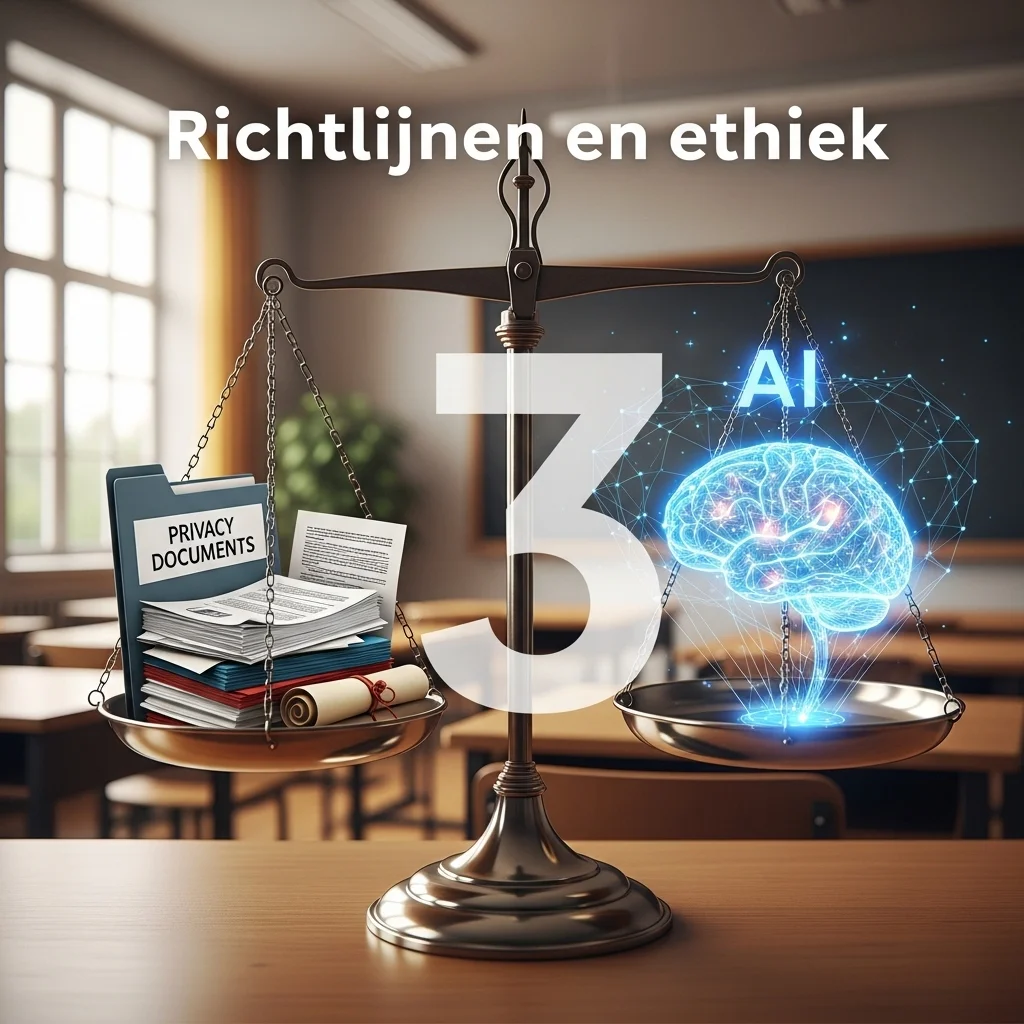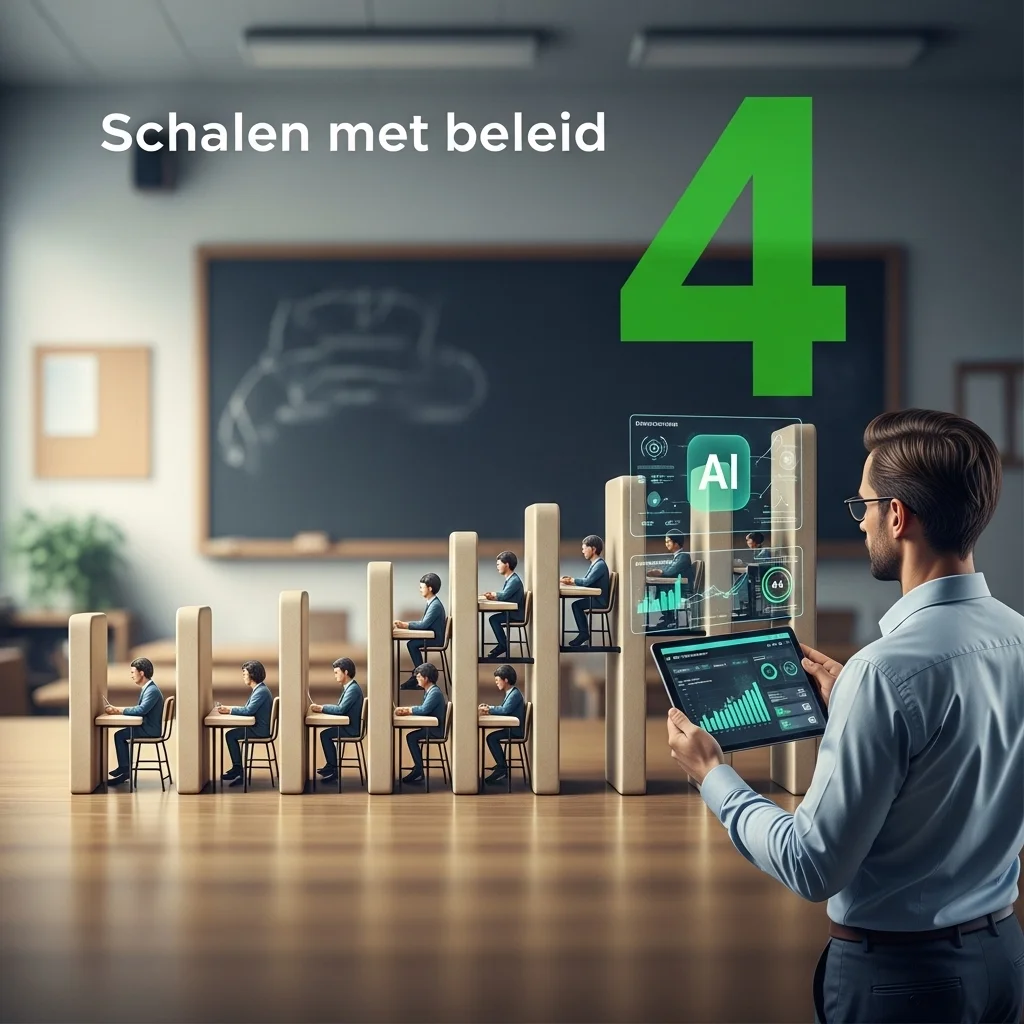Where to start?
Discover the real power of AI without getting lost in hype or buzzwords
Automate
Recurring tasks—think multiple-choice marking or attendance tracking—can be handed over effortlessly to a well-trained model. Teachers report up to 40 % less admin time, freeing them to provide deeper feedback.
Personalise
Adaptive learning paths adjust by the second to a pupil’s level and interests. A maths fan who prefers analysing football statistics? The system serves questions in a sports context—and motivation rises noticeably.
Analyse
Learning analytics spot patterns you would otherwise miss. For instance, quiet Hugo consistently peaks in short practice sessions after lunch—useful insight when creating a personal study plan.
Protect
Privacy-by-design is not a luxury but a necessity. Modern educational AI automatically anonymises data and continually checks for bias, fully aligned with the Dutch Data Protection Authority guidelines.

A classroom is really like an orchestra
A classroom is really like an orchestra: each pupil plays at their own tempo and in their own key while the teacher tries to create a harmonious whole. AI acts as an invisible conductor, cueing every instrument at exactly the right moment.
Time saved
Automatic marking of closed questions removes on average one hour of marking per class per week. That soon adds up.
Better feedback
Generative AI tutors ask probing questions—“Why did you choose this solution?”—and encourage reflection instead of simple yes/no answers.
Insight & intervention
Dashboards link cognitive progress to wellbeing signals (such as log-in rhythm or discussion activity), enabling early intervention when pupils fall behind.
Faster detection of drop-out risks
One-click personalised learning paths
Transparent data reports for parents
Closer alignment with curriculum goals
How do you start with AI in education?.
Theory is great, but the value is in the practice. Follow these steps to get off to a structured start.

Step 1 – Diagnosis.
Do not start by shopping for tools but with a sharp question: “Where are we losing most time?” Gather data from timetables, test analyses and teacher interviews. Often 80 % of frustration overlaps with 20 % of processes—the classic Pareto principle.

Step 2 – Small-scale experimentation.
Choose one subject, one class and one clearly measurable use case. For example, automatic feedback on English essays. Run the pilot for eight weeks so you experience both the technical teething problems and the pedagogical effects.

Step 3 – Guidelines and ethics.
In parallel with the pilot, draw up ground rules: what happens to pupil data? When does the teacher remain ultimately responsible? Involve pupils and parents—transparency builds trust.

Step 4 – Scale sensibly.
Is it working? Great. Only then scale to other subjects. Not in one big wave but in iterations: evaluate, refine and then roll out further. Some teams will move faster, others may hesitate; that is fine.
Professional development: organise a monthly “AI coffee corner” where colleagues share successes and failures. Informal learning moments often have more impact than formal training.

Practical applications today
From marking to parent communication: deploy AI right away
In practice, schools often start with low-threshold tools. One example is the automatic summary function for parent meetings: the teacher talks, the tool takes notes and labels agreements. It sounds small, but it saves five minutes per meeting. With twenty parents that is almost two lessons.
Automating marking
Multiple choice: instantly automatic
Open questions: semantic analysis suggests scores; teacher confirms or adjusts
Generating learning materials
Teachers enter learning objectives, AI compiles practice sets. Images and short explainer videos are automatically included.
In-class differentiation
Quick test completed? The system groups pupils dynamically based on real-time results.

A healthy dose of scepticism
Not every shiny tool solves your problem
AI can take over thinking steps, making pupils less active in their reasoning. As noted earlier, blind trust is risky. The Dutch Data Protection Authority also warns of profiling risks in learning analytics.
Bias & representation
Training data drives behaviour. If datasets mainly contain patterns from highly educated urban groups, rural pupils may be disadvantaged.
Teacher role shifts
AI tutors are handy, but who guards pedagogical quality? Teachers are expected to become more of a coach and less of a broadcaster—a role that not everyone immediately feels comfortable with.
Technical dependency
Systems run in the cloud. If they go down you need a plan B, otherwise learning grinds to a halt.

Looking ahead to 2030
What can we expect in the next five years?
Adaptive learning environments are becoming increasingly visual. Think VR scenarios where physics pupils can “feel” gravity on Mars. Generative AI models will soon create not just text but fully interactive simulations.
Hybrid classrooms
Physical and digital pupils learn side by side. AI synchronises pace and interaction so nobody falls behind.
Micro-credentialing
Pupils earn badges for specific skills. AI validates those badges and passes them on to further education or employers.
Ethics-by-design
Legislation will force vendors to provide explainable algorithms. Transparency moves from nice-to-have to non-negotiable.


Ready for your AI roadmap?
We are happy to spar over your specific educational challenges—no strings attached and no hidden sales pitch. Send us a short message and we will plan a virtual cup of coffee. So, when will you take the first step towards smarter education?
What is the first thing I should do if I want to use AI at school? 😊
Start with a concrete pain-point analysis: where are we losing the most time or quality? Only then choose the technology.
Isn’t AI too expensive for smaller schools? 💸
Many basic features are already included in existing licences or are open source. The biggest investment is usually adoption time, not money.
How about privacy and GDPR? 🔒
Choose tools that anonymise data and provide data-processing agreements. Also check that the servers are located in the EU.
Can’t pupils just get ChatGPT to do all the work? 🤔
They can, but good pedagogy calls for process-oriented assignments. Ask for interim steps or hold discussions about the output.
Will teachers lose their jobs to robots? 😅
No. AI will take over routine tasks, but pedagogical and social interactions remain a human domain—and become even more important.
How do I prevent bias in adaptive systems? ⚖️
Ask vendors about their training data and test the tool with a diverse pilot group. Involve pupils in the evaluation.
Does AI work for early-years education too? 🧸
To a limited extent. Speech recognition can track language development, but human guidance remains crucial at this age.
Do I need to overhaul my entire ICT infrastructure? 🛠️
Not necessarily. Many AI services are cloud-based and integrate via APIs into existing VLEs and student information systems.










.webp)
